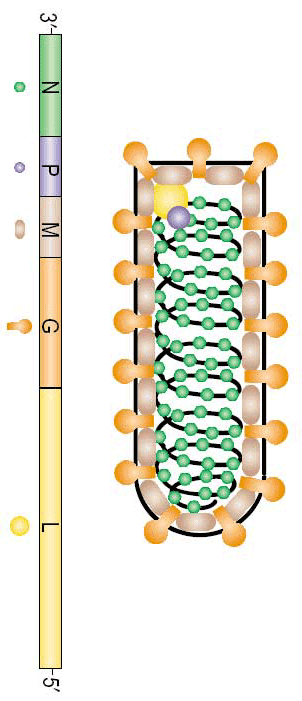Difference between revisions of "Category:Rhabdoviridae"
Jump to navigation
Jump to search
| Line 27: | Line 27: | ||
| − | {{Learning |Vetstream = [https://www.vetstream.com/felis/Content/Bug/bug00214.asp Rabies]}} | + | {{Learning |Vetstream = <P>[https://www.vetstream.com/felis/Content/Bug/bug00214.asp Rabies]</P><P>[https://www.vetstream.com/equis/Content/Disease/dis01018.asp Vesicular Stomatitis Virus]</P>}} |
[[Category:Viral Organisms]] | [[Category:Viral Organisms]] | ||
[[Category:To_Do_-_Clinical/Viruses]] | [[Category:To_Do_-_Clinical/Viruses]] | ||
Latest revision as of 00:12, 16 June 2016
Rhabdoviridae
Rabies is a neurological killer that has evolved a fool-proof technique of transmission, and it cleverly evades the species barrier to present a potent threat to mammalian life. While the simplicity of the virus ensures its transmission, it also contributes to its weakness: its monoclonal antigenicity means that a single vaccination covers all strains of the disease. Though rabies is considered endemic in parts of the developed and undeveloped world, vaccination schemes have rendered the disease controllable to a satisfactory degree. Nonetheless, infection is still largely fatal and the disease should not be taken lightly.
Morphology
- Large, enveloped, negative-sense RNA virus
- Bullet-shaped with short glycoprotein spikes
Types and Subtypes
Two Genera:
- Lyssaviruses: 7 genotypes
- Genotype 1 is classical rabies
- Genotypes 2-7 more limited in distribution
- Genotype 4 infects insectivorous bats
- Vesiculoviruses are all exotic to the UK:
- Vesicular Stomatitis Virus
- Ephemeral Fever
- Fish Rhabdoviruses, such as viral hemorrhagic syndrome and infectious haematopoetic necrosis virus
| Rhabdoviridae Learning Resources | |
|---|---|
To reach the Vetstream content, please select |
Canis, Felis, Lapis or Equis |
Pages in category "Rhabdoviridae"
The following 4 pages are in this category, out of 4 total.
